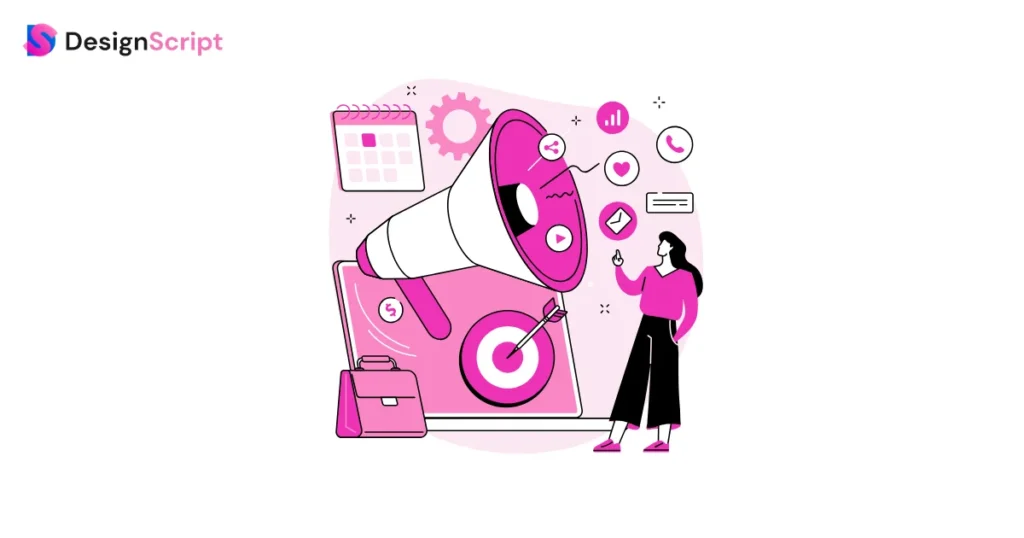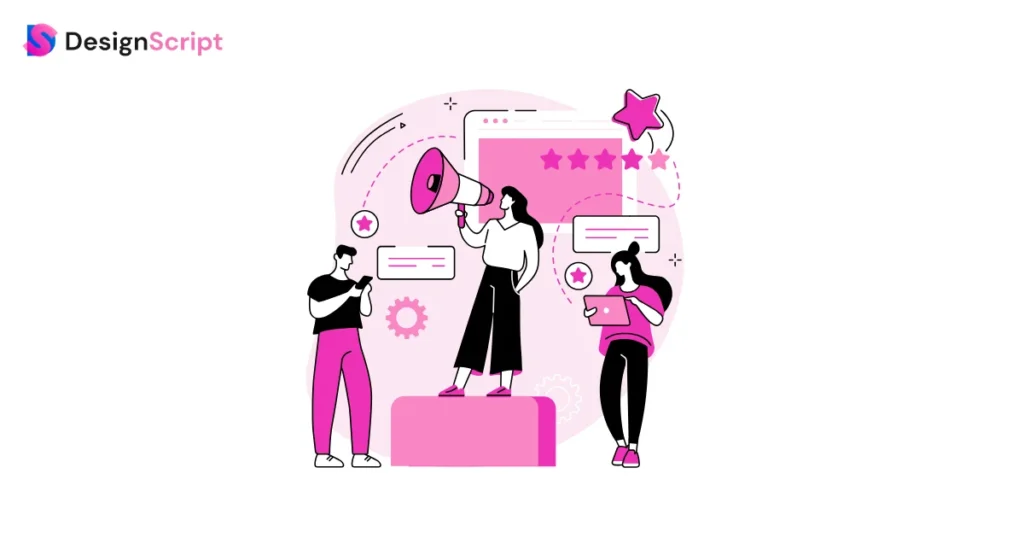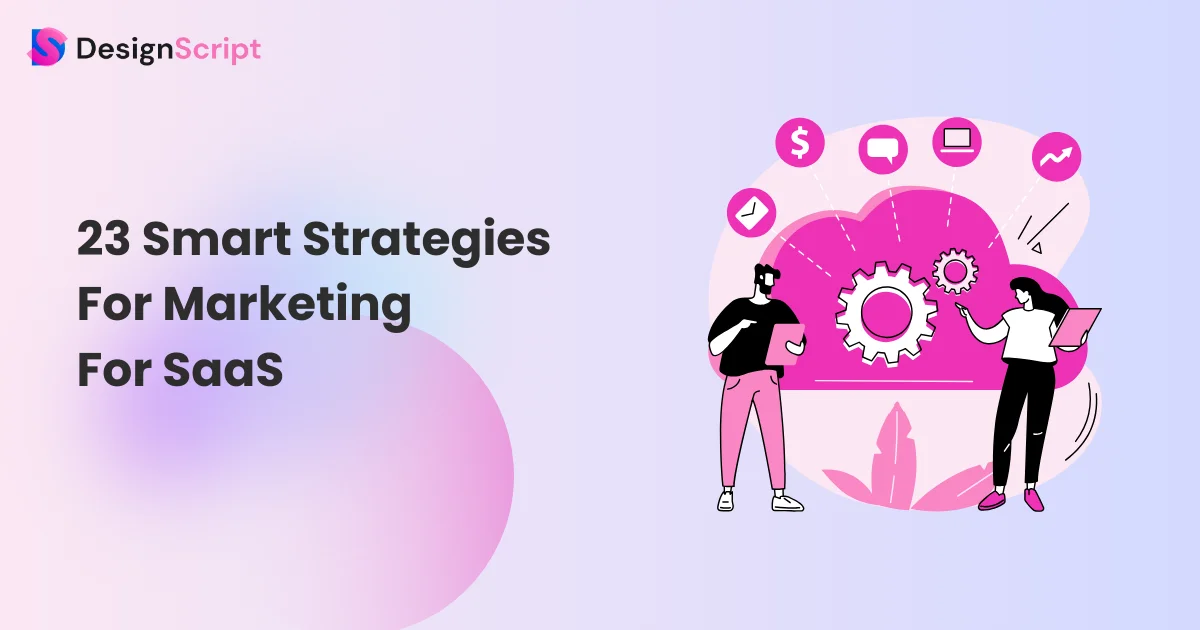23 Smart Strategies For Marketing For SaaS
In 2022, The US Is estimated to have 17,000 Software-as-a-Service Firms. This indicates that it is impossible to stand out from the competition and get clients in the competitive marketing of SaaS.
But fear not!
This blog post is your one-stop for crafting a winning SaaS marketing strategy. We’ll explore 23 effective strategies to help you achieve your growth goals.
We’ll dive into a comprehensive range of tactics, from crafting content with your audience to power of social media and forging strategic partnerships. These insights will provide you with the skills and information you need, regardless of your level of experience as a marketer, to attract leads, engage them, and turn them into devoted clients.
So, get ready to unlock the secrets to SaaS marketing success!
Table of Content
- What is SaaS marketing?
- How Is SaaS Marketing Different From Digital Marketing?
- Why do B2B companies need SaaS marketing?
- SaaS Marketing Strategies
- 1. Perform Customer Research
- 2. Focus on SaaS Content Marketing
- 3. Provide Free SaaS Trials
- 4. Improve Domain Authority
- 5. Run PPC Campaigns
- 6. Leverage SaaS Review Sites
- 7. Incentivize Referrals
- 8. Make SaaS Sign-Ups Easy
- 9. Refine Call To Action
- 10. Work on Social Media Presence
- 11. Focus on Email Marketing Strategies
- 12. Build a Community
- 13. Promote Testimonials and Partnerships on Major Places
- 14. Introduce several Pricing Plans
- 15. Focus on Video Marketing
- 16. Make SEO a Priority
- 17. Leverage SaaS-Centric Review Portals
- 18. Give in-App Product Tours
- 19. Start an Affiliate Program
- 20. Make Booking Calls & Demos easier
- 21. Curate Reviews and Customer Feedback Along with Success Stories
- 22. Avoid Multi-Seat Discounts
- 23. Work on Churn Reduction
- SaaS Marketing Challenges
- Implement The Smart SaaS Marketing Strategies
- FAQs
What is SaaS marketing?
SaaS marketing is a specialized approach to promoting SaaS tools. SaaS businesses concentrate on attracting and keeping members who pay recurring fees instead of selling physical products. This special model necessitates marketing approaches that help build long-lasting ties with customers.
Instead of one-time sales, SaaS marketing aims to convert interested individuals into trial users, then paying subscribers. This often involves offering free trials, product demos, and valuable content that showcases the product’s benefits and addresses customer pain points. Building trust and demonstrating value is crucial, as satisfied customers will likely stay subscribed and recommend the service to others.
Churn rate and customer lifetime value become central to measuring success in SaaS marketing. By understanding these metrics, companies can refine their strategies to attract the right audience, convert them into paying users, and foster long-lasting relationships, ultimately driving sustainable growth.
How Is SaaS Marketing Different From Digital Marketing?

While both involve promoting products online, SaaS marketing and digital marketing have key differences. Digital marketing encompasses a broader range of online plan to reach customers, applicable to any product or service. SaaS marketing, on the other hand, focuses specifically on promoting software-as-a-service products. This unique focus requires a tailored approach, emphasizing factors like:
- Subscription model: SaaS products rely on recurring revenue, so customer retention is crucial. Marketing efforts prioritize building long-term relationships and value.
- Intangible product: Promoting the benefits of software without a tangible product calls for user training and efficient content marketing.
- Data-driven decisions: User data is crucial to SaaS marketing since it allows for analyzing consumer behavior, campaign optimization, and personalization of user experience.
Overall, marketing for SaaS goes beyond just promoting features. It’s about building trust, demonstrating value, and fostering lasting customer relationships in a subscription-based environment.
Why do B2B companies need SaaS marketing?

B2B companies thrive on reaching the right businesses and demonstrating the value of their products. This is where SaaS marketing comes in. It’s like having a specialized toolbox for attracting potential clients, educating them about your software’s benefits, and ultimately converting them into paying customers.
Here’s why it’s crucial:
- Targeted reach: Unlike traditional marketing, SaaS marketing allows you to identify specific businesses that need your solution. This saves time and resources compared to broad, generalized campaigns.
- Educate and engage: B2B buyers are well-informed and research extensively before purchasing. SaaS marketing helps educate them through valuable content, showcasing how your software solves their pain points and enhances their operations.
- Cost-effective and scalable: SaaS marketing offers cost-effective ways to reach your audience compared to traditional marketing methods. It scales efficiently as your business grows, allowing you to adjust your plans based on data and insights.
SaaS marketing equips B2B companies with the right tools and strategies to effectively connect with potential customers, build trust, and drive sustainable growth.
SaaS Marketing Strategies
Dominate the SaaS landscape with a thriving community, diverse pricing options, and engaging video content. This guide delves into 23 actionable strategies to attract, engage, and retain customers, propelling your SaaS business to new heights.
1. Perform Customer Research

Before establishing your array of marketing strategies, undertake a crucial mission: understanding your target audience. Do thorough customer research. Find their demographics, pain points, aspirations, and online behavior. This helps you tailor your messaging, content, and overall approach to resonate deeply with your ideal users. Think of it as creating a personalized battle plan for each customer segment.
2. Focus on SaaS Content Marketing
In the digital realm, content is your most potent weapon. Create high-quality content. It should be informative and engaging. It should educate, entertain, and solve your audience’s problems. This could be blog posts, infographics, ebooks, case studies, or even video tutorials. Remember, consistency is key: maintain a regular content flow to stay top-of-mind and nurture leads through the conversion funnel.
3. Provide Free SaaS Trials

Let your potential users experience the power of your SaaS firsthand. Offer generous free trials with access to key features, allowing them to test-drive your product and witness its value. This lowers the barrier to entry, builds trust, and increases the likelihood of conversion. Consider offering tiered trial options with varying levels of access to cater to different user needs.
4. Improve Domain Authority
In the SEO game, domain authority (DA) is your kingdom’s strength. Implement effective SEO strategies to boost your website’s DA, making it more visible in search engine results pages (SERPs). This includes keyword research, on-page optimization, quality backlinks, and technical SEO improvements. Remember, organic traffic is a valuable, long-term source of leads.
5. Run PPC Campaigns

Pay-per-click (PPC) advertising allows you to reach highly targeted audiences with laser precision. Platforms like Google Ads and LinkedIn Ads let you show your ads to users. These users are actively searching for keywords related to your SaaS solution. Optimize your campaigns for conversions, track results meticulously, and adjust your plan based on data insights.
6. Leverage SaaS Review Sites

Don’t underestimate the influence of online reviews. Encourage satisfied users to leave positive reviews on platforms like Capterra, G2 Crowd, and TrustRadius. They are virtual battlefields. You can show your strengths to them and build trust with potential customers. Respond to both positive and negative reviews accordingly, demonstrating your commitment to customer satisfaction.
7. Incentivize Referrals

The power of word-of-mouth marketing by implementing a referral program. Offer attractive incentives to existing users for recommending your SaaS to others. This can be discounts, free features, or even monetary rewards. Remember, loyal users are your best brand ambassadors, so empower them to spread the good word.
8. Make SaaS Sign-Ups Easy
Frictionless sign-up processes are essential for converting leads into users. Ensure your sign-up forms are simple, intuitive, and need minimal information. Consider offering social login options and eliminating unnecessary steps. Remember, a smooth sign-up experience is like removing obstacles from your battlefield, paving the way for victory.
9. Refine Call To Action

Your call to action (CTA) is your battle cry, urging users to take the next step. Make clear and short CTAs. They should tell users exactly what to do. For example, signing up for a trial, downloading an ebook, or contacting sales. A/B test different CTAs to identify the most effective ones for your audience.
10. Work on Social Media Presence
Don’t underestimate the power of social media and establish a strong presence on platforms relevant to your audience and actively engage with them. Share valuable content. Join industry discussions. Also, run targeted social media ads. Do these to expand your reach and build brand awareness, social media is a powerful tool for building relationships and fostering community.
11. Focus on Email Marketing Strategies

Email marketing remains a highly effective channel for lead nurturing and customer engagement. Segment your audience. Personalize emails and offer valuable content. This will build relationships and drive conversions.
12. Build a Community
Creating a vibrant community fosters brand loyalty and turns users into advocates. Use online forums, social groups, or host webinars. Use them to spark discussions, address concerns, and showcase user success. This builds bonds with your audience. It encourages peer learning and gives useful feedback for product development.
13. Promote Testimonials and Partnerships on Major Places

Displaying positive testimonials and highlighting strategic partnerships on prominent website sections builds trust and credibility. Showcase quotes from satisfied customers alongside logos of renowned companies using your product. This validates your solution, attracts new users, and demonstrates industry recognition.
14. Introduce several Pricing Plans
Offer distinct pricing tiers tailored to different user segments and needs. It caters to budgets and usage patterns. It attracts individual users, small teams, and larger enterprises. Clearly communicate the features and benefits of each plan. This helps inform decision-making and adoption by many user groups.
15. Focus on Video Marketing

Incorporate video marketing into your strategy. Product demos, explainer videos, and customer testimonials are engaging. They convey your value clearly and show features in action. They also help you connect with your audience on an emotional level. Make video content work for different platforms. Use social media ads to reach more people.
16. Make SEO a Priority
Use organic search engine optimization (SEO) best practices. They increase your website’s visibility in search results. Do keyword research to find relevant search terms. Then, optimize website content and get backlinks from reputable sources. Better SEO brings organic traffic. It brings potential customers to your product and fuels growth.
17. Leverage SaaS-Centric Review Portals
Encourage user reviews on platforms like G2 Crowd, Capterra, and TrustRadius. These platforms are for SaaS products. They let potential customers compare features, read unbiased reviews, and make informed decisions. Respond to both good and bad reviews as soon as possible and accordingly. This shows your commitment to pleasing customers.
18. Give in-App Product Tours
Integrate guided in-app product tours within your platform. The walkthroughs are interactive. They highlight key features and address common pain points. They show the value proposition in an engaging way which helps users understand your product’s potential quickly. It reduces onboarding friction and encourages faster adoption.
19. Start an Affiliate Program

Partner with individuals or businesses aligned with your target audience to promote your product. Offer attractive commission structures for successful referrals. This uses the reach and influence of your partners. It also expands your sales network. It gives them an incentive to champion your product to their audience.
20. Make Booking Calls & Demos easier
Optimize your website and marketing materials to simplify booking calls and demos. Offer clear options, many scheduling platforms, and consider incorporating automated appointment scheduling tools. This reduces friction from the conversion process. It encourages engagement and lets potential customers try your product.
21. Curate Reviews and Customer Feedback Along with Success Stories

Put positive customer reviews, testimonials, and case studies on your website. Also, include them in your marketing materials. Share success stories highlighting how your product helped clients achieve specific goals. This builds trust, shows real impact and positions you as a reliable solution for potential customers.
22. Avoid Multi-Seat Discounts
While tempting, offering significant multi-seat discounts can have adverse effects. It devalues your product. It incentivizes users to add unnecessary seats and cuts long-term revenue. Consider other strategies. For example, use tiered pricing or volume-based discounts. They still encourage adoption without hurting your profits.
23. Work on Churn Reduction

Focus on retaining existing customers as much as acquiring new ones. Conduct churn analysis to identify factors leading to user drop-off and address pain points proactively. Offer personalized support. Use strategies like customer success programs to increase user engagement and satisfaction. Retaining existing customers is cost-effective and fuels recurring revenue growth.
By using these diverse strategies you can build a thriving SaaS business and it will have a loyal customer base. Remember to measure your efforts, adapt to changing markets. Use data insights to optimize your marketing for growth and success.
SaaS Marketing Challenges

The SaaS industry thrives on innovation and competition, but even the most groundbreaking products face hurdles in their marketing journeys. Here are four prominent challenges that SaaS businesses often encounter:
1. Brand awareness
Standing out in a deep sea of competitors can be challenging, especially for new businesses. Because established players may already have a strong brand identity, it might be challenging to draw in new clients and educate your audience and position your company as a thought leader by producing interesting and educational content. Utilize PPC campaigns and social media advertising to reach your ideal customer profile. Collaborate with relevant industry influencers to generate brand awareness and credibility.
2. Customer loyalty
Encouraging customers to stick with your SaaS product in a world of alternatives can be challenging. Customers switch to competitors offering similar features or pricing options. Provide prompt, helpful, and personalized support to build trust and satisfaction. Continuously improve your product with new features and updates that address customer needs. Reward customers for their continued patronage through loyalty programs and exclusive benefits.
3. Customer service
In the SaaS world, exceptional customer service is not a luxury; it’s a necessity. Unresolved issues and negative experiences can quickly damage your reputation and lead to churn. Ensure you have adequate resources and well-trained personnel to handle customer inquiries efficiently. Provide various options for customers to reach support, such as live chat, email, and phone. Work on customer feedback and use it to improve your product and service offerings.
4. Technical issues
SaaS products rely heavily on technical infrastructure and functionality. Any downtime or technical problems might ruin the user experience and harm your company’s reputation. Select scalable and flexible systems to support your expanding user base and avoid interruptions. Thoroughly test new features and updates before deploying them to ensure smooth operation. Have a plan to identify and address technical issues promptly and effectively.
SaaS companies may successfully traverse the competitive landscape and achieve sustainable development by recognizing these obstacles and implementing effective plans to solve them. Recall that creating a great SaaS brand involves a dedication to providing outstanding value, ongoing innovation, and a customer-centric mindset.
Implement The Smart SaaS Marketing Strategies
The world of SaaS marketing is full of chances but also has difficulties. This blog post gives you 23 strategies. Conquer challenges to boost your SaaS business.
To be successful, you need to know your audience and create a message that connects with what they want. Utilize various marketing tools like content marketing, social media, and SEO for growth. Cultivate loyal customers and achieve sustainable growth through email marketing.
Don’t be scared to experiment and adapt your strategies based on data and market trends. Always prioritize customer satisfaction and provide service to keep churn at bay. Consistently deliver value. Build a thriving community around your product. Establish your SaaS brand as a leader.
FAQs
Content, SEO, social media, email, paid ads, influencer marketing, and community building. Pick 2-3 based on your audience & goals.
Focus on where your target audience spends more time. Facebook groups, LinkedIn for professionals, Twitter for news in the business, etc. Test ideas and monitor outcomes.
Track website traffic, leads generated, conversions, customer acquisition costs, and churn rate. Use analytics tools & A/B testing to optimize campaigns.

